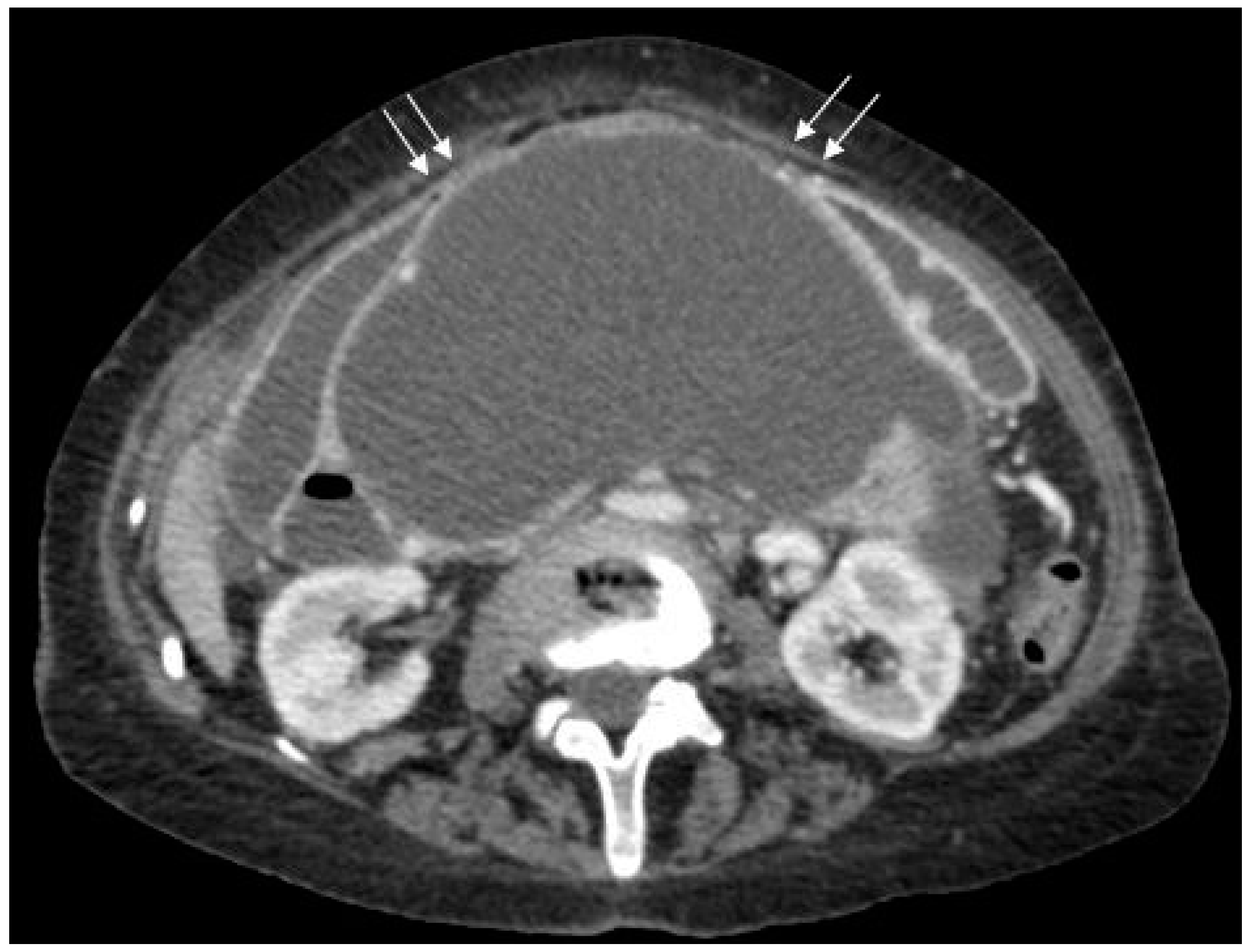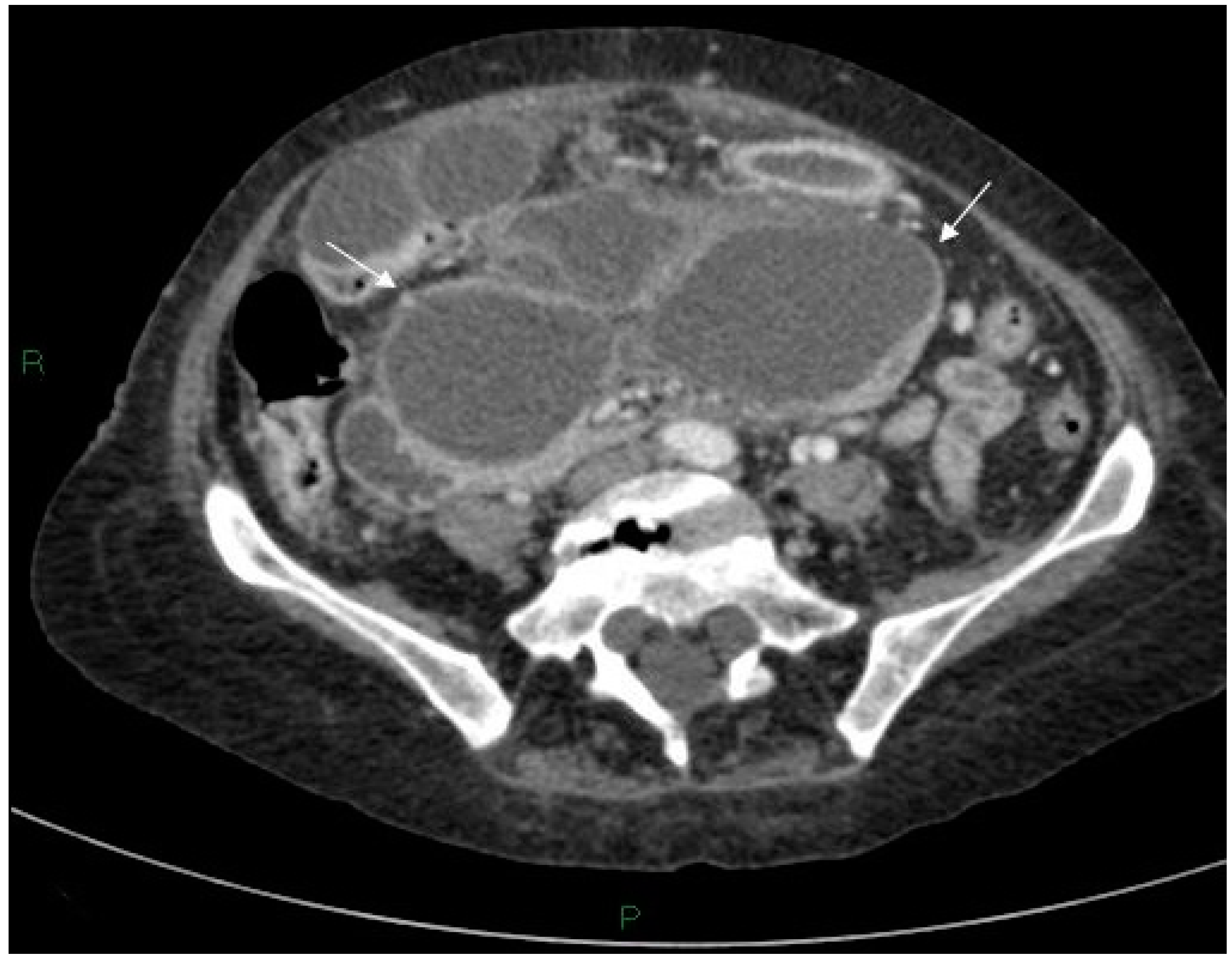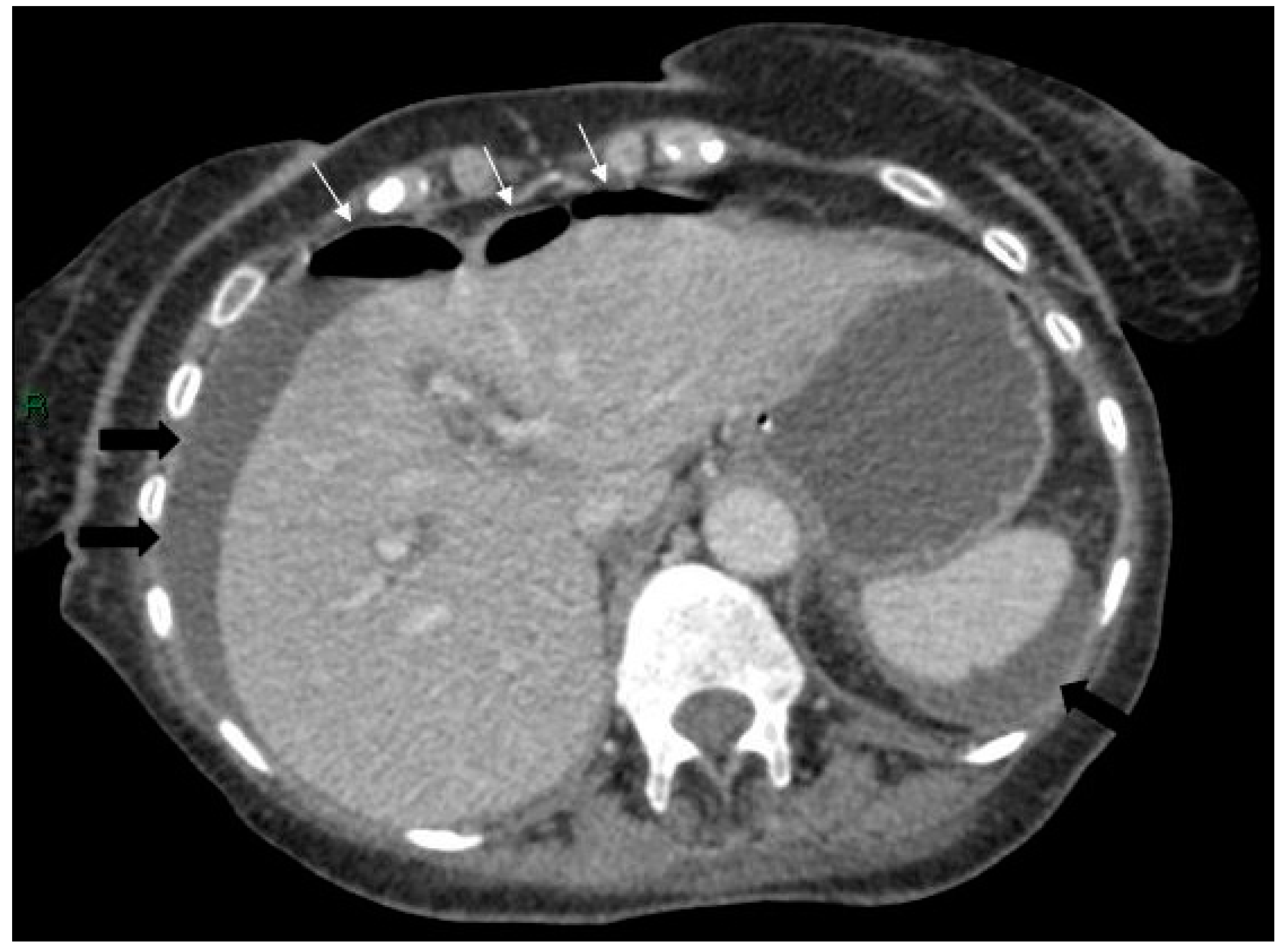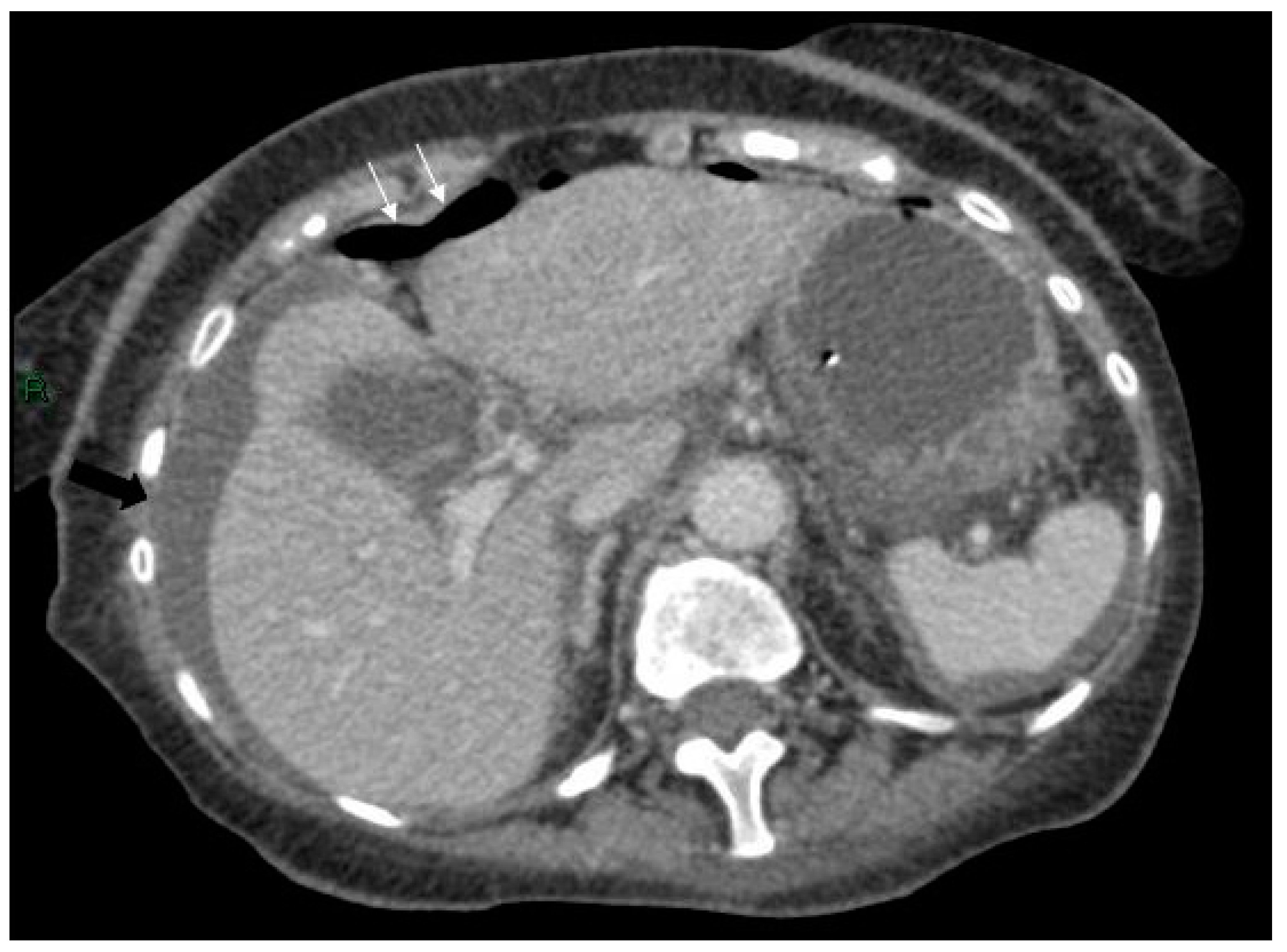Mechanical Duodenal Perforation Due to Complications of Pancreatic Pseudocysts
Abstract
1. Introduction
2. Case Presentation Section
3. Discussion
4. Conclusions
Author Contributions
Funding
Conflicts of Interest
References
- Banks, P.A.; Bollen, T.L.; Dervenis, C.; Gooszen, H.; Johnson, C.D.; Sarr, M.G.; Tsiotos, G.G.; Vege, S.S. Classification of acute pancreatitis—2012: Revision of the Atlanta classification and definitions by international consensus. Gut 2012, 62, 102–111. [Google Scholar] [CrossRef] [PubMed]
- D’Egidio, A.; Schein, M. Pancreatic pseudocysts: A proposed classification and its management implications. BJS 1991, 78, 981–984. [Google Scholar] [CrossRef] [PubMed]
- Bradley, E.L. A Clinically Based Classification System for Acute Pancreatitis. Arch. Surg. 1993, 128, 586–590. [Google Scholar] [CrossRef] [PubMed]
- Wang, Y.; Abu Omar, Y.; Agrawal, R.; Gong, Z. Comparison of treatment modalities in pancreatic pseudocyst: A population based study. World J. Gastrointest. Surg. 2019, 11, 365–372. [Google Scholar] [CrossRef] [PubMed]
- Varadarajulu, S.; Bang, J.Y.; Sutton, B.S.; Trevino, J.M.; Christein, J.D.; Wilcox, C.M. Equal Efficacy of Endoscopic and Surgical Cystogastrostomy for Pancreatic Pseudocyst Drainage in a Randomized Trial. Gastroenterology 2013, 145, 583–590. [Google Scholar] [CrossRef] [PubMed]
- King, B.; Speziale, A. Gastric perforation caused by a pancreatic pseudocyst. Gastrointest. Endosc. 2011, 74, 1403–1404. [Google Scholar] [CrossRef] [PubMed]
- Aghenta, A.A.; Kim, H.J. An Unusual Case of Colon Perforation Complicating Acute Pancreatitis. Case Rep. Gastroenterol. 2009, 3, 207–213. [Google Scholar] [CrossRef] [PubMed]
- Ertuğrul, I.; Yüksel, I.; Parlak, E.; Başar, Ö.; Uçar, E.; Şahin, B. Gastric Necrosis Due to Rapidly Growing Pancreatic Pseudocyst. Am. J. Gastroenterol. 2008, 103, 2949–2951. [Google Scholar] [CrossRef]
- Hsu, C.-Y.; Lee, K.-C.; Chan, C.-C.; Lee, F.-Y.; Lin, H.-C. Gastric Necrosis and Perforation as a Severe Complication of Pancreatic Pseudocyst. J. Chin. Med. Assoc. 2009, 72, 603–606. [Google Scholar] [CrossRef]
- Cannon, J.W.; Callery, M.P.; Vollmer, C.M. Diagnosis and Management of Pancreatic Pseudocysts: What is the Evidence? J. Am. Coll. Surg. 2009, 209, 385–393. [Google Scholar] [CrossRef] [PubMed]
- Tuboku-Metzger, V.R.; Seenath, M.M.; Tan, L.C. Peritonitis secondary to traumatic duodenal laceration in the presence of a large pancreatic pseudocyst: A case report. J. Med Case Rep. 2011, 5, 528. [Google Scholar] [CrossRef]
- Pitchumoni, C.; Agarwal, N. Pancreatic Pseudocysts. Gastroenterol. Clin. N. Am. 1999, 28, 615–639. [Google Scholar] [CrossRef]
- Andren-Sandberg, A.; Dervenis, C. Pancreatic pseudocysts in the 21st century. Part I: Classification, pathophysiology, anatomic considerations and treatment. JOP J. Pancreas 2004, 5, 8–24. [Google Scholar]
- Ocampo, C.; Oría, A.; Zandalazini, H.; Silva, W.; Kohan, G.; Chiapetta, L.; Alvarez, J. Treatment of Acute Pancreatic Pseudocysts After Severe Acute Pancreatitis. J. Gastrointest. Surg. 2007, 11, 357–363. [Google Scholar] [CrossRef]
- Gurusamy, K.S.; Pallari, E.; Hawkins, N.; Pereira, S.P.; Davidson, B.R. Management strategies for pancreatic pseudocysts. Cochrane Database Syst. Rev. 2016, 2016. [Google Scholar] [CrossRef]
- Aghdassi, A.A.; Mayerle, J.; Kraft, M.; Sielenkämper, A.W.; Heidecke, C.-D.; Lerch, M.M. Pancreatic pseudocysts—When and how to treat? HPB 2006, 8, 432–441. [Google Scholar] [CrossRef] [PubMed]
- Gurusamy, K.S.; Nagendran, M.; Davidson, B.R. Early versus delayed laparoscopic cholecystectomy for acute gallstone pancreatitis. Cochrane Database Syst. Rev. 2013, 2013, CD010326. [Google Scholar]





© 2020 by the authors. Licensee MDPI, Basel, Switzerland. This article is an open access article distributed under the terms and conditions of the Creative Commons Attribution (CC BY) license (http://creativecommons.org/licenses/by/4.0/).
Share and Cite
George, J.; Fysaraki, C.; Harris, H.J.; Ravi, K.; White, T.J. Mechanical Duodenal Perforation Due to Complications of Pancreatic Pseudocysts. Reports 2020, 3, 10. https://doi.org/10.3390/reports3020010
George J, Fysaraki C, Harris HJ, Ravi K, White TJ. Mechanical Duodenal Perforation Due to Complications of Pancreatic Pseudocysts. Reports. 2020; 3(2):10. https://doi.org/10.3390/reports3020010
Chicago/Turabian StyleGeorge, Jayan, Chrysoula Fysaraki, Heather J. Harris, Krishnamurthy Ravi, and Timothy J. White. 2020. "Mechanical Duodenal Perforation Due to Complications of Pancreatic Pseudocysts" Reports 3, no. 2: 10. https://doi.org/10.3390/reports3020010
APA StyleGeorge, J., Fysaraki, C., Harris, H. J., Ravi, K., & White, T. J. (2020). Mechanical Duodenal Perforation Due to Complications of Pancreatic Pseudocysts. Reports, 3(2), 10. https://doi.org/10.3390/reports3020010




